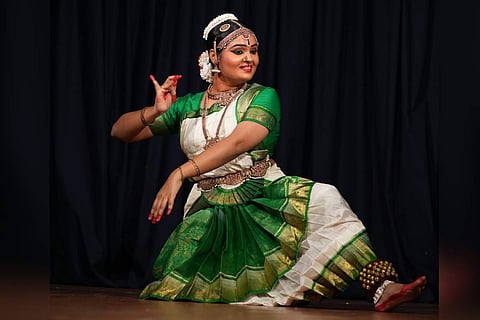
- LIFESTYLE
- FASHION
- FOOD
- ENTERTAINMENT
- EVENTS
- CULTURE
- VIDEOS
- WEB STORIES
- GALLERIES
- GADGETS
- CAR & BIKE
- SOCIETY
- TRAVEL
- NORTH EAST
- INDULGE CONNECT

Her demanding corporate job left her no time to pursue what she had been learning since she was only five years old — Bharatanatyam, from her mother and guru, Vidya Bhavani Suresh. It’s been three years since she last danced! But a year back, on one ‘not so’ fine day, something snapped in her and Mahitha Suresh decided she was going to dance again. A year later, she is all set to stage Tamizh Ilakkiyamum Bharathamum, a Bharatanatyam production based entirely on ancient and hoary texts from Tamizh literature.
“With the hustle bustle of corporate life especially in the beginning of your career, dance took a backseat for me. After a few years, I started to feel very unilateral. I kept thinking that I wasn’t putting Bharatanatyam to any use. So, I wanted to make an effort to start doing what I love — dance,” Mahitha says.
Mahitha felt very close to her mother’s cause — to bring relevant content into Bharatanatyam, which is much more neutral and which doesn’t project women, in a slightly objectified light. “It was fundamentally my mother’s thought and idea, but it resonated with me as I grew up. You realise chauvinism is a reality; even in the corporate sector while you want to believe the world is changing, you still sometimes come across situations where it hits you that you’re a woman and you have to go an extra mile to make an impact. So, the profundity of what my mother said — ‘When we are on the stage to display our art, why should it be about pining for a lover or waiting for the husband to come back, or wondering what he’s been up to?’ — made a lot of sense.”
Mahitha will be performing Penn, an extract from Thiruvengai Kalambagam; Ramayana and Ishaindha Erum from Thiruppugazh; Osai from Paripadal; Maa Irul from Thirumurugatrupadai; and Ammanai from Meenakshiammai Pillai Tamizh.
Penn
This piece is a take on the plight of women in royalty. It unfolds as a dialogue between a hunter and the king’s messenger. The king has seen the hunter’s daughter and fallen in love with her and wishes to marry her, and so, sends a marriage proposal through his messenger. Contrary to the joyous reaction that we might have expected the hunter to show, he instead asks: ‘Which king has the right to ask for a girl’s hand in marriage?’ “Typically, performances commence with more footwork-centric pieces like Pushanjali and then progress into content-heavy pieces. This piece is placed as the first item on the programme, an unconventional placement, given its intriguing theme and Abhinaya-heavy content, to ensure the audience has an unusual viewing experience,” Mahitha says.
Ramayana
This piece is a short retelling of the Ramayana. It takes off on an unexpected note — the Roudra Rasa (anger). “While anger is generally conveyed as a part of various narratives, it is rare to find a Bharatanatyam piece that commences on an angry note. The piece begins with the anger of Kaikeyi, who has just come to know of Rama’s coronation, and is livid with rage,” Mahitha shares.
Osai
This piece elaborates upon the beauty of sound. The poet, who is travelling up the hillock of Thirupparankundram, is fascinated by the sounds he hears along the way. On the one side are the veena players, who play sweet music. Then, the bee believes it can do better and starts making its own sound. The poet observes and compares various sounds, the flautists versus the wasp, muzhavu players versus the thundering sounds of a waterfall and the singers, who sing melodiously, to match what the peacock vocalises. “This is the most unique part of the piece, for, we have seen the dance of the peacock being admired and written about, but here, the poet talks about the voice of the peacock,” the dancer says.
Maa Irul
This one is an extract from Thirumurugatrupadai devoted to Lord Karthikkeya. The Lord is believed to have six faces. This particular extract is metaphorical, in the sense that it interprets the six faces to be six aspects of the Lord.
Ishaindha Erum
This is also from Thiruppugazh in praise of Lord Shiva and in particular, describes the adornments of Lord Shiva. His mount is the bull, Nandi, he wears the sacred ash and thread and is dressed in tiger skin. He wears a string of pearls in his matted locks.
Ammanai
Here, Goddess Meenakshi, the presiding deity of the Meenakshi Amman Temple at Madurai, is visualised by the poet as a child. The goddess/child is playing ammanai, a traditional ball-game. As the child plays, one ball reflects the pink colour of her palm, another, the black of her eyes and the third, the white colour of her teeth. Through this game, the goddess reveals the three qualities of human nature, rajas (red), tamas (black) and sattva (white).
Open to all.
December 10, 6.30 pm.
At The Music Academy – Kasturi Srinivasan Hall, Alwarpet.
Email: rupam@newindianexpress.com
X: @rupsjain